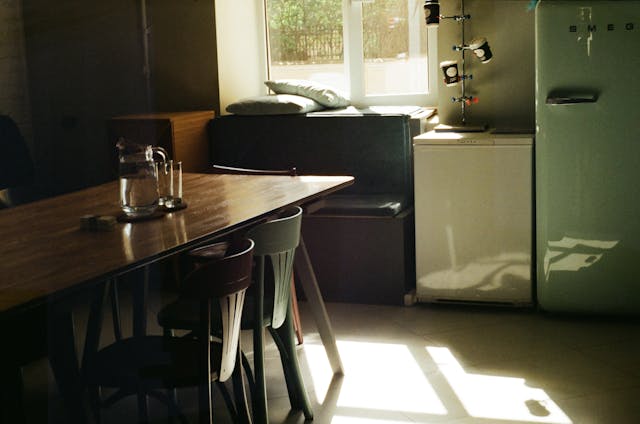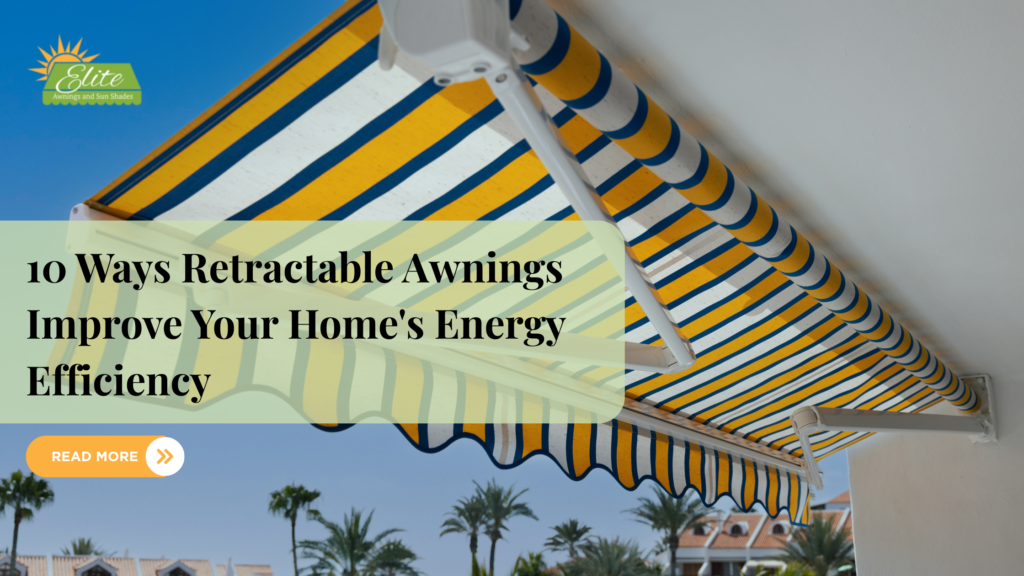- Retractable awnings block direct sunlight, keeping indoor spaces cooler and reducing the need for air conditioning.
- They provide flexible, year-round energy efficiency. Extend them in summer to prevent overheating and retract them in winter to allow sunlight to naturally warm your home.
- Beyond cooling, they also protect furniture, improve ventilation, and create comfortable outdoor spaces without using extra energy.
Energy costs keep rising, and homeowners are looking for smarter ways to keep their houses cool without overloading the air conditioner. One of the most effective yet often overlooked solutions is retractable awnings. These simple additions can significantly cut down indoor heat, reduce cooling expenses, and create a more comfortable living space—without increasing electricity consumption.
But how exactly do they work? And what makes them such an effective energy-saving solution?
Before looking into the 10 key ways they improve energy efficiency, let’s take a closer look at how heat enters your home and why blocking it matters.
Understanding Energy Efficiency & Solar Heat Gain
Solar heat gain is the amount of heat your home absorbs from the sun. When sunlight hits windows, walls, and roofs, it transfers heat inside. Without proper shading, indoor temperatures can rise quickly, forcing the HVAC system to work harder to maintain a comfortable environment.
Windows are the biggest source of unwanted heat. According to the U.S. Department of Energy, about 76% of the sunlight that falls on a window turns into heat indoors. This can cause rooms to feel stuffy, increase cooling costs, and make it harder to maintain steady indoor temperatures.
One of the most effective ways to stop this heat before it enters your home is by installing retractable awnings. Unlike fixed structures, these can be adjusted based on the season or time of day, allowing for maximum shade in summer and sunlight access in winter.
10 Ways Retractable Awnings Improve Energy Efficiency
Now, let’s break down how retractable awnings directly contribute to a more energy-efficient home.
1) Blocks Direct Sunlight to Reduce Indoor Heat
One of the most direct ways retractable awnings help with energy efficiency is by blocking solar radiation before it enters your home. When sunlight hits windows, it turns into radiant heat, making indoor spaces noticeably warmer. If you have large windows, glass doors, or sun-exposed areas, you probably know how quickly rooms can heat up during the day.
By shading the most heat-prone areas, you create a cooler environment naturally—without overworking your HVAC system. Reducing direct sun exposure also slows the thermal transfer process, meaning heat doesn’t linger in your home’s walls and floors. This keeps indoor temperatures more stable throughout the day, reducing the need for mechanical cooling.
2) Cuts Down on Air Conditioning Costs
With less direct sunlight entering your home, your air conditioner won’t have to work as hard to keep rooms comfortable. When heat is blocked before it reaches your windows, the cooling load inside your home is significantly reduced.
Air conditioners consume a lot of electricity, and running them for extended periods can lead to higher energy bills. With retractable awnings, you can:
- Set the thermostat higher without sacrificing comfort
- Run the AC for shorter durations, using less power
- Reduce wear and tear on your cooling system, making it last longer
By preventing excess heat from entering, retractable awnings allow you to cool your home more efficiently, leading to noticeable savings over time.
3) Creates Cooler Outdoor Spaces Without Extra Power
Patios, decks, and outdoor seating areas can become unbearably hot when exposed to direct sunlight. In many cases, homeowners resort to electric outdoor fans, misting systems, or cooling units to keep the space comfortable—all of which add to energy consumption.
A retractable awning offers an immediate cooling solution without using electricity. With proper placement, these awnings can reduce outdoor temperatures by 10-20°F, making patios and decks enjoyable even during peak summer heat.
This allows you to:
- Spend more time outside without overheating
- Reduce reliance on cooling devices that consume power
- Protect outdoor furniture from excessive sun exposure
For those who love outdoor dining, lounging, or entertaining guests, this is a simple and energy-efficient way to maximize the use of your exterior spaces.
4) Reduces Heat Absorption on Walls and Windows
Sunlight doesn’t just enter your home through windows—it also warms exterior walls, which then radiate heat inside. The more heat your walls absorb, the harder it is to cool indoor spaces.
By installing retractable awnings over sun-exposed windows and doors, you create a protective barrier that prevents heat from soaking into your home’s structure. This reduces the heat retention effect, keeping indoor temperatures stable and reducing fluctuations between day and night.
This is especially beneficial for homes with brick, stucco, or dark-colored exteriors, as these materials absorb and retain heat more than lighter surfaces.
5) Protects Furniture, Flooring, and Décor from UV Damage

Sunlight streaming through windows may brighten a room, but over time, it can take a toll on interior furnishings. Constant UV exposure can cause flooring to fade, furniture to lose its original color, and delicate materials to weaken or crack.
Hardwood floors, upholstered furniture, carpets, and even artwork are especially vulnerable. Once the damage is done, restoring these surfaces can be costly and time-consuming.
Retractable awnings can create a protective barrier that reduces the intensity of sunlight entering your home. This helps maintain the look and durability of your interiors, allowing you to enjoy your furnishings for much longer without worrying about premature fading or wear.
6) Prevents Heat Buildup in Glass Doors and Large Windows
Glass is one of the biggest culprits when it comes to heat gain. Sliding doors, picture windows, and skylights act like magnifying glasses, trapping heat inside and increasing indoor temperatures. This is known as the greenhouse effect, and it’s a major reason why homes heat up so quickly in summer.
By installing retractable awnings over these glass-heavy areas, you create a buffer zone that prevents heat from accumulating. This keeps rooms cooler and reduces the strain on your HVAC system.
Skylights, in particular, benefit from shading solutions like awnings, as they are often placed on rooftops where sunlight exposure is at its highest.
7) Supports Natural Ventilation for a Fresher Home
Many homeowners keep their windows shut during hot weather to avoid letting warm air inside. However, this also limits natural airflow, leading to stale indoor air, higher humidity, and reduced ventilation.
With retractable awnings, you can keep windows open while maintaining shade, allowing for better air circulation. This creates a cross-ventilation effect, where cooler outdoor air enters while warm air escapes, reducing indoor heat buildup.
Better ventilation means:
- Lower humidity levels, reducing the risk of mold and mildew
- Less reliance on air conditioning for fresh air
- A healthier indoor environment with improved air quality
By using awnings strategically, you can promote natural cooling methods that work with the environment rather than against it.
8) Lowers the Heat Island Effect Around Your Home
Urban and suburban areas experience the heat island effect, where buildings, roads, and other artificial surfaces absorb and retain heat, making cities significantly warmer than surrounding rural areas.
By shading your home’s exterior with retractable awnings, you reduce heat absorption and cool the area immediately around your home. This benefits your household and also contributes to a cooler neighborhood environment.
Shaded areas around the home also mean lower ground temperatures, which can improve outdoor comfort and reduce the need for additional cooling methods.
9) Works Year-Round by Adjusting for Seasonal Changes
Unlike fixed awnings, retractable awnings offer seasonal flexibility. You can extend them fully in summer to block heat and retract them in winter to allow more sunlight to warm your home.
This seasonal adjustability is a key advantage because it prevents excess heat in summer, allows passive solar heating in winter, and helps regulate indoor temperatures throughout the year.
This means you’re not just saving on cooling costs in summer, but also on heating costs in winter—making your home energy-efficient in all seasons.
10) Increases Home Value with Energy-Efficient Design
Energy-efficient homes are more desirable to buyers. Installing retractable awnings improves both the aesthetic and functional appeal of your home, making it more attractive in the real estate market.
Key benefits for homeowners include:
- Lower energy bills, which potential buyers see as a long-term advantage
- Improved curb appeal, making your home more visually appealing
- Enhanced outdoor living space, increasing usable square footage
Whether you plan to sell in the future or simply want to increase your home’s efficiency, retractable awnings are a practical and stylish investment.
Additional Energy-Saving Tips
While retractable awnings play a major role in keeping your home cool, combining them with other smart energy-saving strategies can maximize efficiency.
Here are a few additional ways to reduce indoor heat and lower cooling costs:
Use Window Coverings Indoors
Even with outdoor shading, heat can still seep through windows. Adding thermal curtains, blinds, or solar shades inside your home provides an extra layer of protection. Closing them during the hottest parts of the day can help maintain cooler indoor temperatures.
Plant Trees and Shrubs Strategically
Landscaping can work alongside awnings to block heat. Planting trees, tall bushes, or climbing vines near sun-exposed windows creates natural shade. Over time, this can help insulate your home from intense sunlight while also improving curb appeal.
Choose Light-Colored Outdoor Surfaces
Darker surfaces, like asphalt driveways and black roofs, absorb more heat, which can raise surrounding temperatures. If you’re considering a home upgrade, opt for lighter-colored roofing, pavement, and exterior walls to reflect heat instead of trapping it.
Improve Ventilation
Even with shading, hot air can build up indoors. Use ceiling fans, attic vents, or cross-ventilation techniques to help push warm air out and keep your home feeling fresh. Combining these methods with retractable awnings makes cooling even more effective.
Upgrade your home with a retractable awning that blends style and function. At Elite Awnings & Sun Shades, we offer high-quality shading solutions that lower energy consumption and keep your indoor spaces cooler. Book a free in-home consultation today and discover the benefits of customized shade!

